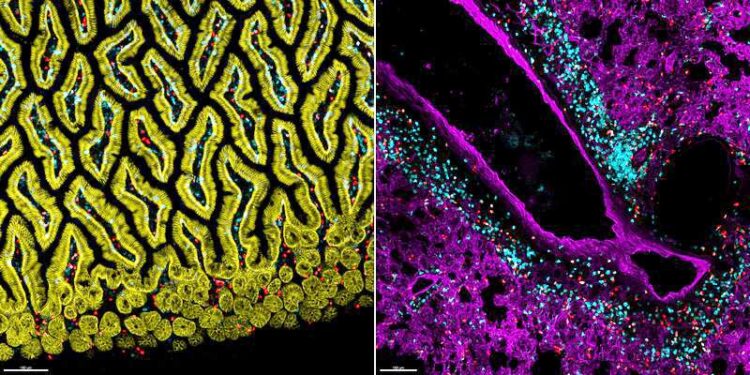Immune cells as guests in the tissue

Immunzellen in verschiedenen Geweben, hier zum Beispiel ILC2s (rot) oder T-Zellen (blau) in der Lunge (rechts) oder in der Schleimhaut des Dünndarms (links).
Ye Ouyang / Georg Gasteiger
Specialized immune cells settle permanently in tissues of the body and build “local task forces”. Wuerzburger scientists have recently discovered, how these cells can regenerate themselves and can adapt to the new environment.
When a pathogen invades the human body there has to be a rapid reaction in order to keep the damage to a minimum. Special immune cells act as a first line of defence. So-called innate lymphoid cells – in short ILCs- are located in mucosal tissue sites such as the lung, skin and intestine, where they can fight harmful pathogens at an early stage. In contrast to many other immune cells that have to be activated to move to the place of action at the periphery of our body, ILCs settle in tissues and organs shortly after birth and stay there permanently.
In search for local progenitor cells
Few details have been known about the life cycle of these cells. This has now changed: Scientists at the Max Planck Research group in the Institute of Systems Immunology of the Julius-Maximilians-University of Wuerzburg (JMU) studied ILCs in the lung, which play an important role in diseases like asthma but also in viral and parasitic infections. Georg Gasteiger, Chair of Systems Immunology II, explains: “We wanted to understand how ILCs develop and how they adapt and specialize in specific tissue environments. We also asked if there could be tissue-specific progenitor cells that may generate and refresh the resident ILCs.”
In order to answer these questions the Wuerzburg scientists and colleagues from the Max Planck Institute of Freiburg teamed up and measured all mRNA-molecules from individual ILCs of the lung. With this single cell “molecular fingerprints” and the help of machine learning methods they could derive the developmental steps of lung ILCs which were then tested with refined experimental systems.
A comprehensive atlas of local immune cells
The results of their work are now published in the scientific journal Immunity. “We were able to generate a comprehensive atlas of all ILCs that are present in the lung. At the same time we could identify different kinds of progenitor cells: some that are circulating in the body and others that reside in the lung permanently”, describes Georg Gasteiger the major findings from this study.
“This work shows how immune cells that originate from different locations of the body can adapt to local tissue niches. This suggests that it is not the origin but the local interactions in the niches that are the key factors that affect the identity and function of the ILCs.”
ILCs have multiple jobs
ILCs reside in various tissues where they interact with many cell types and contribute to immune surveillance, activation of inflammatory responses, tissue homeostasis and repair and barrier functions. The researchers from Würzburg were looking at a specific subtype of cells in the lung, so-called ILC2s. They play an important role in the immune response against parasitic worm infections, but have also been associated with asthma. In addition, they take over the key function of protecting the lung from tissue damage during viral infections.
Immigrants support resident cells
From recent studies from the Wuerzburger systems immunologists it is known that ILC2s can migrate into the lung from other tissues during an infection. But it was unclear if these cells temporarily support the local defence cells with specialized functions or if they permanently integrate at that location in order to replenish the pool of resident cells. To understand these mechanisms, researchers of Wuerzburg together with colleagues in Freiburg, Berlin, Marseille and New York generated a comprehensive single cell atlas of the ILC populations in the bone morrow and the lung tissue under normal, physiological conditions and during a helminth infection.
They came across progenitor cells that migrate from bone marrow into the tissue and that have the potential to generate the whole spectrum of lung ILC2s during an infection. These cells could also be detected in peripheral blood and lung samples from tumor patients. Based on these results, these cells can now be isolated from the patients’ blood to analyse how they are changed during different diseases. Furthermore, the scientists want to find out how these cells can be modulated in the laboratory to be used for immune therapy.
Wissenschaftliche Ansprechpartner:
Prof. Dr. Georg Gasteiger, chair of Systemimmunologie II, T: +49 931 31-89599, georg.gasteiger@uni-wuerzburg.de
Originalpublikation:
In situ maturation and tissue adaptation of type 2 innate lymphoid cell progenitors. Patrice Zeis, Mi Lian, Xiying Fan, Josip S. Herman, Daniela C. Hernandez, Rebecca Gentek, Shlomo Elias, Cornelia Symowski, Konrad Knöpper, Nina Peltokangas, Christin Friedrich, Remi Doucet-Ladeveze, Agnieszka M. Kabat, Richard M. Locksley, David Voehringer, Marc Bajenoff, Alexander Y. Rudensky, Chiara Romagnani, Dominic Grün, Georg Gasteiger. Immunity 53, 1–18. https://doi.org/10.1016/j.immuni.2020.09.002
Media Contact
All latest news from the category: Health and Medicine
This subject area encompasses research and studies in the field of human medicine.
Among the wide-ranging list of topics covered here are anesthesiology, anatomy, surgery, human genetics, hygiene and environmental medicine, internal medicine, neurology, pharmacology, physiology, urology and dental medicine.
Newest articles

Parallel Paths: Understanding Malaria Resistance in Chimpanzees and Humans
The closest relatives of humans adapt genetically to habitats and infections Survival of the Fittest: Genetic Adaptations Uncovered in Chimpanzees Görlitz, 10.01.2025. Chimpanzees have genetic adaptations that help them survive…

You are What You Eat—Stanford Study Links Fiber to Anti-Cancer Gene Modulation
The Fiber Gap: A Growing Concern in American Diets Fiber is well known to be an important part of a healthy diet, yet less than 10% of Americans eat the minimum recommended…

Trust Your Gut—RNA-Protein Discovery for Better Immunity
HIRI researchers uncover control mechanisms of polysaccharide utilization in Bacteroides thetaiotaomicron. Researchers at the Helmholtz Institute for RNA-based Infection Research (HIRI) and the Julius-Maximilians-Universität (JMU) in Würzburg have identified a…



